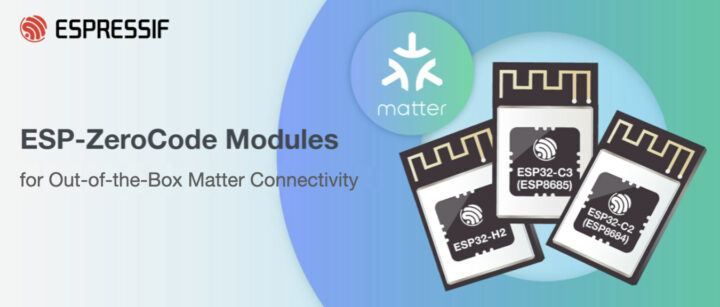Espressif Systems has just announced the Matter-compatible ESP-ZeroCode modules with Wi-Fi and/or Thread (802.15.4) wireless connectivity that are designed as plug-and-play solutions for LED lights, outlets, switches, dimmers, relays, fans, and other lighting and electrical devices.
I was only recently introduced to no-code programming in a recent post by Ninephon Kongangkab explaining how to use SenseCraft firmware for no-code programming on Wio Terminal. Basically, there’s no need to know Arduino, MicroPython, or any programming language, as the user just has to press a few buttons to configure an IoT device to meet his/her requirements. With the ESP-ZeroCode modules, Espressif offers something similar using several of their ESP32 chips.
The first ESP-ZeroCode modules will be offered with either ESP32-C3 (aka ESP8685) or ESP32-C2 (aka ESP8684) WiFi & BLE RISC-V SoCs, or ESP32-H2 802.15.4 & BLE RISC-V microcontroller, and ships with a Matter compatible firmware that enables “near-zero investment in development”. Not it’s not entirely clear whether those are zero-code or just “little-code” (better known as low code) programming devices 🙂
In any case, Matter support will mean the modules will work with Apple HomeKit, Google Home, Amazon Alexa, or other Matter-compatible solutions out of the box, and there won’t be any need for custom mobile apps or voice-assistant skills. The “ESP-ZeroCode for Matter” modules will primarily connect to the Cloud for OTA upgrades. That’s unless you go with the “ESP-ZeroCode for Matter with RainMaker” that adds a private IoT Cloud solution via the company’s ESP RainMaker.
All modules will be pre-provisioned with device certificates (DAC), Espressif will maintain the firmware with security fixed and potentially new features, and handle OTA upgrades and device management using the ESP RainMaker’s device management. Customization of the modules will also be possible, but we don’t have much detailed technical information at this stage, although I’d assume those are probably based on existing hardware ESP32-C3/C2/H2 modules flashed with a custom “ZeroCode” firmware. Further details should eventually become available on the product page, and you may also get additional information in the announcement.

Jean-Luc started CNX Software in 2010 as a part-time endeavor, before quitting his job as a software engineering manager, and starting to write daily news, and reviews full time later in 2011.
Support CNX Software! Donate via cryptocurrencies, become a Patron on Patreon, or purchase goods on Amazon or Aliexpress





